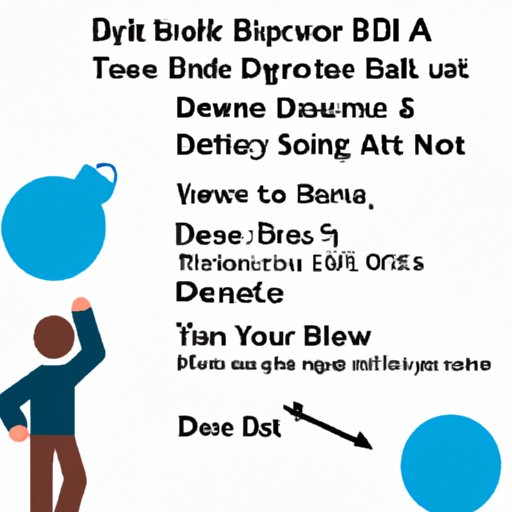
I. Introduction
Debt can be a challenging and stressful burden to bear, and it’s not uncommon to feel overwhelmed and helpless in the face of accumulating debt. While paying off debt may seem like an impossible task, with careful planning and a commitment to a plan, it’s possible to become debt-free. In this article, we explore different strategies you can use to pay off your debts, outlining the benefits and drawbacks of each method.
II. Create a Budget Plan
The first step to paying off your debts is to create a budget plan. Start by listing all of your debts, including their minimum monthly payments, interest rates, and the time remaining to pay them off. Once you have a clear understanding of your debt, you can create a budget plan that allocates a portion of your income towards paying off your debts each month. This will require carefully evaluating your financial situation and cutting back on unnecessary expenses.
III. Debt Consolidation
Debt consolidation involves combining your debts into a single loan or credit card balance transfer, usually at a lower interest rate, which can help you save money and pay off debts faster. One option is to take out a personal loan to pay off all of your debts, leaving you with a single payment each month at a lower interest rate than your credit cards. Another option is to use a balance transfer credit card, which typically offers low or zero interest rates for a set period of time, allowing you to pay off your debts interest-free.
IV. Snowball Method
The snowball method involves paying off the smallest debts first, regardless of interest rates, while continuing to make minimum payments on your larger debts. This approach provides a psychological boost as you see your smaller debts disappear more quickly, motivating you to continue paying off your debts. Once you’ve paid off your smallest debt, you can move on to the next smallest and continue this process until you’ve cleared all of your debts.
Some tips for making the snowball method more effective include focusing on debts with low-balance, automating your payments, and finding ways to increase your income to pay off debts more quickly.
V. Reverse Snowball Method
The reverse snowball method involves paying off the debt with the highest interest rate first while continuing to make the minimum payments on your other debts. This approach offers a more financially logical approach where you’ll save money on interest over time, allowing you to pay off your debts faster. Once the debt with the highest interest rate is paid off, you can move on to the next highest interest rate and continue this process until all your debts are cleared.
Some tips for making the reverse snowball method more effective include finding ways to negotiate lower interest rates, minimizing expenses, and focusing on extra payments to reduce your debt faster.
VI. Increase Your Income
Increasing your income can be an effective way to pay off your debts more quickly. This can involve taking on an additional job, freelancing or finding remote work, or starting a side business. With each additional source of income, you can allocate more funds towards paying off your debts, speeding up the process and freeing yourself from the burden of debt more quickly.
Some tips for making this tactic more effective include setting clear goals, being patient and persistent, and finding work that can be done during your free time and complements your primary job.
VII. Seek Help
If you’ve tried different strategies and are still struggling to pay off your debts, it may be time to seek professional help. This can include credit counseling organizations, debt relief services, and financial advisors. These services can offer you guidance, negotiate with your creditors, and help you develop a personalized plan to pay off your debts more effectively.
When looking for professional help, it’s important to do your research and choose a reputable service. Look for established organizations with positive customer feedback and independent certifications
VIII. Conclusion
Paying off debt can be a challenging process, but with the right strategies and a committed mindset, it’s possible to become debt-free. By creating a budget plan, considering debt consolidation, using the snowball or reverse snowball method, increasing your income, and seeking professional help when necessary, you can take control of your finances and pave the way for a more secure financial future.
Remember, persistence and patience are key when paying off debt. Stay motivated, stay committed, and don’t give up until you’ve accomplished your goals.




